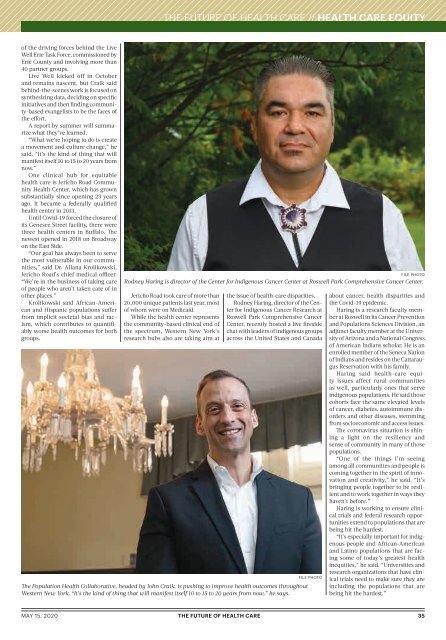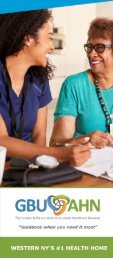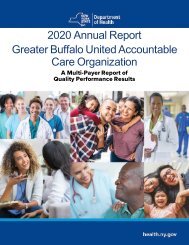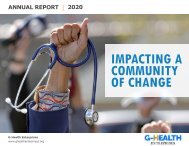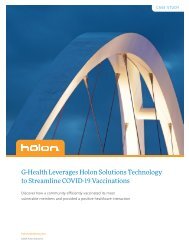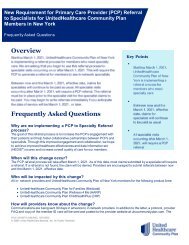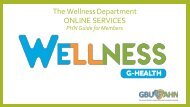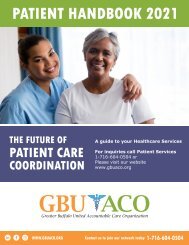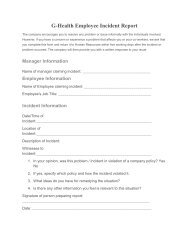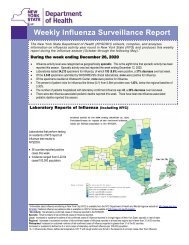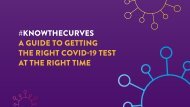Future of Health Care 2020
- No tags were found...
Create successful ePaper yourself
Turn your PDF publications into a flip-book with our unique Google optimized e-Paper software.
THE FUTURE THE FUTURE OF HEALTH OF HEALTH CARE // HEALTH CARE // PATIENT CARE EQUITY CARE<br />
<strong>of</strong> the driving forces behind the Live<br />
Well Erie Task Force, commissioned by<br />
Erie County and involving more than<br />
40 partner groups.<br />
Live Well kicked <strong>of</strong>f in October<br />
and remains nascent, but Craik said<br />
behind-the-scenes work is focused on<br />
synthesizing data, deciding on specific<br />
initiatives and then finding community-based<br />
evangelists to be the faces <strong>of</strong><br />
the effort.<br />
A report by summer will summarize<br />
what they’ve learned.<br />
“What we’re hoping to do is create<br />
a movement and culture change,” he<br />
said. “It’s the kind <strong>of</strong> thing that will<br />
manifest itself 10 to 15 to 20 years from<br />
now.”<br />
One clinical hub for equitable<br />
health care is Jericho Road Community<br />
<strong>Health</strong> Center, which has grown<br />
substantially since opening 23 years<br />
ago. It became a federally qualified<br />
health center in 2013.<br />
Until Covid-19 forced the closure <strong>of</strong><br />
its Genesee Street facility, there were<br />
three health centers in Buffalo. The<br />
newest opened in 2018 on Broadway<br />
on the East Side.<br />
“Our goal has always been to serve<br />
the most vulnerable in our communities,”<br />
said Dr. Allana Krolikowski,<br />
Jericho Road’s chief medical <strong>of</strong>ficer.<br />
“We’re in the business <strong>of</strong> taking care<br />
<strong>of</strong> people who aren’t taken care <strong>of</strong> in<br />
other places.”<br />
Krolikowski said African-American<br />
and Hispanic populations suffer<br />
from implicit societal bias and racism,<br />
which contributes to quantifiably<br />
worse health outcomes for both<br />
groups.<br />
Rodney Haring is director <strong>of</strong> the Center for Indigenous Cancer Center at Roswell Park Comprehensive Cancer Center.<br />
Jericho Road took care <strong>of</strong> more than<br />
20,000 unique patients last year, most<br />
<strong>of</strong> whom were on Medicaid.<br />
While the health center represents<br />
the community-based clinical end <strong>of</strong><br />
the spectrum, Western New York’s<br />
research hubs also are taking aim at<br />
the issue <strong>of</strong> health-care disparities.<br />
Rodney Haring, director <strong>of</strong> the Center<br />
for Indigenous Cancer Research at<br />
Roswell Park Comprehensive Cancer<br />
Center, recently hosted a live fireside<br />
chat with leaders <strong>of</strong> indigenous groups<br />
across the United States and Canada<br />
The Population <strong>Health</strong> Collaborative, headed by John Craik, is pushing to improve health outcomes throughout<br />
Western New York. “It’s the kind <strong>of</strong> thing that will manifest itself 10 to 15 to 20 years from now,” he says.<br />
FILE PHOTO<br />
FILE PHOTO<br />
about cancer, health disparities and<br />
the Covid-19 epidemic.<br />
Haring is a research faculty member<br />
at Roswell in its Cancer Prevention<br />
and Populations Sciences Division, an<br />
adjunct faculty member at the University<br />
<strong>of</strong> Arizona and a National Congress<br />
<strong>of</strong> American Indians scholar. He is an<br />
enrolled member <strong>of</strong> the Seneca Nation<br />
<strong>of</strong> Indians and resides on the Cattaraugus<br />
Reservation with his family.<br />
Haring said health-care equity<br />
issues affect rural communities<br />
as well, particularly ones that serve<br />
indigenous populations. He said those<br />
cohorts face the same elevated levels<br />
<strong>of</strong> cancer, diabetes, autoimmune disorders<br />
and other diseases, stemming<br />
from socioeconomic and access issues.<br />
The coronavirus situation is shining<br />
a light on the resiliency and<br />
sense <strong>of</strong> community in many <strong>of</strong> those<br />
populations.<br />
“One <strong>of</strong> the things I’m seeing<br />
among all communities and people is<br />
coming together in the spirit <strong>of</strong> innovation<br />
and creativity,” he said. “It’s<br />
bringing people together to be resilient<br />
and to work together in ways they<br />
haven’t before.”<br />
Haring is working to ensure clinical<br />
trials and federal research opportunities<br />
extend to populations that are<br />
being hit the hardest.<br />
“It’s especially important for indigenous<br />
people and African-American<br />
and Latino populations that are facing<br />
some <strong>of</strong> today’s greatest health<br />
inequities,” he said. “Universities and<br />
research organizations that have clinical<br />
trials need to make sure they are<br />
including the populations that are<br />
being hit the hardest.”<br />
MAY 15, <strong>2020</strong> THE FUTURE OF HEALTH CARE 35


